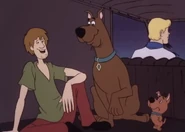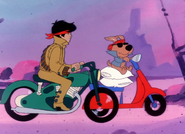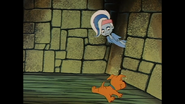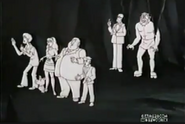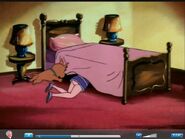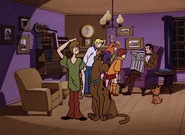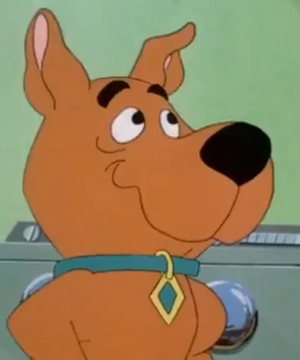
Scrappy-Doo is a fictional Great Dane puppy created by Hanna-Barbera in 1979 as the nephew of Hanna-Barbera cartoon star Scooby-Doo. Scrappy has appeared in a number of the various incarnations of the Scooby-Doo cartoon series.[1][2] Lennie Weinrib provided his voice for one season in 1979 and from 1980 on, it was performed by Don Messick (who voiced Scooby).
His "birthday" is April 28th.
About Scrappy[]
Scrappy has a contradicted origin. Originally as shown in the introduction of the series episodes, Scrappy only met his Uncle Scooby after becoming a young pup. But in the December 1980 episode of Scooby-Doo and Scrappy-Doo, "Scrappy's Birthday" depicts Scrappy-Doo's birth, which both Scooby and Shaggy attend. Born at St. Bernard's Hospital to Scooby-Doo's sister Ruby-Doo on December 20, 1979. Scrappy idolizes his uncle Scooby and would often assist Scooby and his friends in solving mysteries (Scrappy saves Scooby several times from monsters when they were looking for the rest of the gang shown). With a highly energetic and brave personality, despite his small size, Scrappy was the exact opposite of his uncle; Scrappy would usually insist on trying to directly fight the various monsters Scooby and his associates encountered and generally have to be dragged away by Scooby. Related to this, one of Scrappy's catchphrases was, "Lemme at 'em! I'll splat 'em!" Another of Scrappy-Doo's catchphrases is, "Ta dadada ta daaa! (imitating a bugle playing "Charge!") Puppy power!", he is also quite strong, capable of smashing down solid rock walls. The character was developed by writer Mark Evanier, who has acknowledged basing Scrappy's personality largely on that of the Looney Tunes character Henery Hawk.[3]
In Scooby-Doo Meets the Boo Brothers, Scooby-Doo and the Ghoul School and Scooby-Doo and the Reluctant Werewolf, Scrappy is more toned down, as he is less feisty and a little more cowardly, but still much braver than Scooby and Shaggy. In all three movies he sometimes serves as the brains of the trio, figuring out the clues and where to go next. Also, the idea of Scrappy actually may not have been all that new to the series, as he "...bore a resemblance to Spears and Ruby’s initial idea for a feisty little dog", which was one of the early ideas for the Scooby-Doo character himself along with the "big cowardly dog" ultimately chosen.[4]
Voice Cast[]
Mel Blanc was apparently the first choice, according to Evanier. This would have been interesting, considering Scrappy's connection to Henery Hawk, who was voiced by Blanc. Blanc was reportedy interested, but eventually ruled out by Joseph Barbera, possibly because of concerns about Blanc's price. The second consideration was Frank Welker, who coined the catch phrase "Puppy Power." He would later change this to "Monkey Muscle" for the similar Donkey Kong Jr. character he would voice for CBS-TV's Saturday Supercade. The next choice was Messick, who was seen as giving the best audition, but still deemed "the wrong voice". Afterward, other well known cartoon voice actors were considered or suggested: Paul Winchell, Howard Morris, Dick Beals and even Marilyn Schreffler. Ultimately, Weinrib was chosen, and after the first season, Messick became the final voice of Scrappy for the rest of the series' run.
History[]
Scrappy remained an integral part of the Scooby-Doo franchise, on both TV and in Scooby-related licensed products and merchandising, through the end of the 1980s. He was also briefly the star of his own seven-minute shorts — the Scrappy and Yabba-Doo segments of The Scooby & Scrappy-Doo/Puppy Hour. Teamed with his uncle Yabba-Doo and Deputy Dusty, Scrappy helped maintain law and order in a small town in the American west. In later years, the presence of Scrappy-Doo has been criticized as having had a negative impact on the various Scooby-Doo series of the 1980s.[5] However, the gradual decline of Scooby-Doo has been credited to other factors as well, such as changes in format.[6] Scrappy-Doo has become the symbol of an irritatingly overexuberant or cute character added to a series in an attempt to maintain ratings, a phenomenon also known as Cousin Oliver Syndrome. Due to the general perception of the character by audiences, Scrappy-Doo has not appeared in any Scooby-related spinoffs since the made-for-television movie Scooby-Doo and the Reluctant Werewolf in 1988, with three exceptions:
- The first live-action Scooby-Doo theatrical film — In the live-action Scooby-Doo film, Scrappy played a decidedly negative and darker role as the main villain, wanting revenge on Mystery Inc. for abandoning him years ago: He was kicked out for continuously urinating on Daphne, being obnoxious, and the final straw was when he tried to vote himself as the leader of Mystery Inc. When Velma is talking to a guy at the bar who likes her, she tells him that Scrappy was not a puppy, but had a glandular disorder. Although he nearly succeeds in performing the 'Darkopolypse Ritual', which would give a group of demons the power to rule Earth for the next ten thousand years, his plan is foiled and he and his minions are arrested because he underestimated the Mystery Inc. team, inviting them all to the theme park where he was conducting the ritual after they broke up years before simply to make them witness his triumph when he only needed Scooby present, intending to use Scooby's 'pure' soul to complete his ritual. At the conclusion of the film, Velma says that Scrappy's full name is Scrappy Cornelius Doo. This U-turn in Scrappy's character could be a reference to the first film in the Mission Impossible series, in which long-famous hero Jim Phelps (the original hero in the original Mission Impossible television series) became a traitor and the film's main villain after finally becoming disillusioned with his work, and was shockingly revealed as the main villain at the climax of the film.
- Scooby-Doo and the Goblin King (2008) has a scene where a monstrous Mystery Machine crashes through a carnival stand containing dolls of Scrappy, and running over them. As in all the previous direct-to-video movies, Scrappy never made an appearance.
- Scooby-Doo! Mystery Incorporated (2010-2013) has a scene in "The Siren's Song" where Daphne notices and admires a statue of Scrappy while Daphne and Fred were talking at the museum. Fred turned Daphne away from the statue, telling her they promised not to talk about Scrappy anymore, most likely due to Scrappy's annoying behavior, for which he got banned from Mystery Inc.
- In 2019's Scooby-Doo and the Curse of the 13th Ghost, a now young adult Flim Flam mentions his adventures with Daphne, Shaggy, Scooby, and Scrappy in the original 13 Ghosts series, to which Velma responds by asking, “what's a Scrappy?”
Appearances[]
Series[]
- Scooby-Doo and Scrappy-Doo (half-hour version) (1979–1980)
- Scooby-Doo and Scrappy-Doo (seven-minute version) (1980–1983)
- Scrappy and Yabba-Doo (1982)
- The All-New Scooby and Scrappy-Doo Show (1983–1984)
- The New Scooby-Doo Mysteries (1984–1985)
- The 13 Ghosts of Scooby-Doo (1985)
Telefilms[]
- Scooby-Doo Meets the Boo Brothers (1987)
- Scooby-Doo and the Ghoul School (1988)
- Scooby-Doo and the Reluctant Werewolf (1988)
Feature Films[]
- Scooby-Doo (2002) (non-canon)
Other Appearances[]
- Scrappy-Doo appeared in a few Cartoon Network commercial bumpers, reflecting on the negative criticism of the character. One such bumper has him hanging outside Cartoon Network's office, ranting about how the other cartoons are getting better treatment than he, despite Scrappy's creation being twenty years earlier. At the end, Scrappy responds to the tagline (the best place for cartoons) with, "Not for me! Not for me, man!"
- Scrappy-Doo is a running gag in Harvey Birdman, Attorney at Law. He first appears at the end of "Shaggy Busted" to utter his catchphrase, but is cut-off halfway when Avenger grabs Scrappy in his talons. From then on, Scrappy's corpse appears in various episodes, usually being carried around by Avenger. He also appears in the Drawn Together episode "Lost in Parking Space, Part Two", wherein he and several other cartoon characters are brutally tortured. He appears in the "Laff-a-Munich" skit in the Robot Chicken episode "Ban on the Fun", in which Blue Falcon kicks Scrappy into a lake. And in January of the years 2008, 2009, 2010 and 2011, Scrappy was made the King of Boomer-royalty in which, each weekend, the channel "Boomerang" showed two-hour installments of Scooby-Doo and Scrappy-Doo all month.
- Scrappy-Doo appears on a milk carton in the Jellystone! episode "Bleep".
Gallery[]
References[]
- ↑ Pfanner, Eric (2006-02-19). "Underdog takes shot at giants in kids television". The New York Times. http://www.nytimes.com/2006/02/19/technology/19iht-toon20.html?scp=6&sq=scrappy%20doo&st=cse. Retrieved 2010-08-14.
- ↑ "TV Playbook: Let's Add a Kid!". IGN. http://uk.tv.ign.com/articles/935/935812p5.html. Retrieved 2010-08-15.
- ↑ http://www.newsfromme.com/archives/2007_03_16.html#013108
- ↑ John Latchem, "Scooby-Doo Still Going Strong on DVD"; Home Media Magazine, Oct. 20, 2007
- ↑ /http://www.theshiznit.co.uk/feature/top-10-most-annoying-movie-kids.php Top 10 Most Annoying Movie Kids
- ↑ http://www.everwonder.com/david/scooby/happened/index.html
External Links[]
- Scrappy Days: The Birth of Scrappy-Doo and What I Had to Do With It (A memoir by Mark Evanier recalling his role in creating Scrappy-Doo, and the ensuing struggle to get him to screen)
